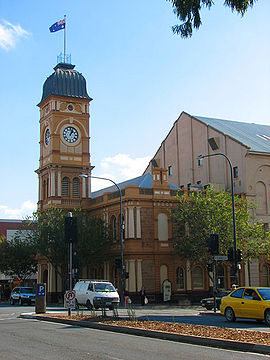Kensington and Norwood Corporation
|
City of Kensington and Norwood South Australia |
|||||||||||||||
|---|---|---|---|---|---|---|---|---|---|---|---|---|---|---|---|

Norwood Town Hall, formerly the council headquarters
|
|||||||||||||||
| Coordinates | 34°55′15″S 138°38′11″E / 34.920940°S 138.636433°ECoordinates: 34°55′15″S 138°38′11″E / 34.920940°S 138.636433°E | ||||||||||||||
| Established | 1853 | ||||||||||||||
| Abolished | 1997 | ||||||||||||||
| Area | 3.92 km2 (1.5 sq mi) | ||||||||||||||
| Council seat | Norwood | ||||||||||||||
|
|||||||||||||||
The City of Kensington and Norwood was a local government area in South Australia from 1853 to 1997, centred on the inner Adelaide suburbs of Kensington and Norwood.
It was proclaimed on 7 July 1853 as the Corporate Town of Kensington and Norwood, covering the then villages of Kensington, Norwood and Marryatville. The town extent was defined as sections 260, 261, 276, 277, 289, and 290 of the Hundred of Adelaide, corresponding to land beside First Creek and Second Creek enclosed by the modern suburbs of Norwood, Marryatville, Kensington and Heathpool. It was the first municipal corporation in South Australia after the City of Adelaide.
The council was divided into three wards at its inception: West Norwood, East Norwood and Kensington.Charles Bonney was unanimously elected as the first mayor.
On 18 September 1856, it gained Kent Town from the District Council of Burnside, which was then incorporated as Kent Ward. This was the only change ever made to the council's boundaries. These boundaries were defined as Dequetteville Terrace, Kensington Road, Portrush Road, the southern and eastern boundaries of section 290, Shipster's Road, East Parade, Kensington Terrace, Magill Road and North Terrace. In 1878, the municipality had a population of 6500, which had doubled by the mid-1880s.
The original Kensington and Norwood Town Hall was built in 1859 and demolished in 1897. The present Norwood Town Hall was opened in 1883, and received extensive additions in 1914. The council undertook a significant program of tree planting in its early years, and managed three municipal plantations. In 1905, the council was given Norwood Oval as a gift in trust, and managed it thereafter.
...
Wikipedia

